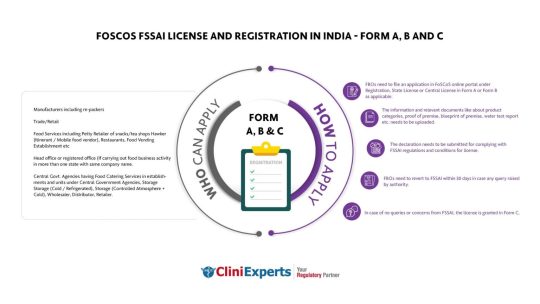Don't wanna be here? Send us removal request.
Text
Dive into the world of Software as a Medical Device (SaMD)

Discover how software turns into a medical device and learn about the fundamentals of SaMD. Recognize its effects, uses, and legal requirements in the medical field.
0 notes
Text
NOC for Form 29: Simple Process to Obtain Approval

Discover the simplest process to apply for and obtain your NOC for Form 29. Follow our guide to ensure timely approval and avoid common application errors.
0 notes
Text
Delhi's FSSAI Licenses Explained: Types and Application Process

Get a clear understanding of the types of FSSAI license in Delhi. Learn how to apply for the appropriate license to ensure your food business meets all legal requirements.
0 notes
Text
Step-by-Step Guide to 21 CFR Part 801 Compliance in the USA

Follow this step-by-step guide to achieve 21 CFR Part 801 labeling compliance for medical devices in the USA.
0 notes
Text
Essential Guide to FSSAI License Renewal in India

Keep your food business compliant with our essential guide to FSSAI license renewal. Understand the renewal requirements, documentation, and steps to renew your FSSAI license in India.
#fssai#fssai license#fssai license renewal#fssai license renewal in india#fssai license renewal online
0 notes
Text
Revised Schedule M: A New Era for Pharmaceutical Marketing
Explore the potential of the Revised Schedule M to revolutionize pharmaceutical marketing. Get insights into compliance, best practices, and strategies to leverage this new regulation effectively.
0 notes
Text
CDSCO Sent off Extra Structures on Public Single Window Framework (NSWS) Entry to smooth out corporate exchanges and give a solitary resource for all financial backer endorsements.
0 notes
Text
#CosmeticsRegistration#CosmeticRegulation#CosmeticIndustry#RegulatoryAffairs#CosmeticCertification#CosmeticBusiness
0 notes
Text
CliniExperts provides a comprehensive guide for obtaining an FSSAI license or registration, essential for anyone involved in the food business in India. The website details the types of FSSAI licenses—Basic, State, and Central—based on the size and scale of the business, as well as the turnover.
0 notes
Text
How to Secure FosCos FSSAI Food License & Registration
Navigating the intricate landscape of India's food industry necessitates acquiring the FosCos FSSAI Food License & Registration. This license, issued by the Food Safety and Standards Authority of India (FSSAI), is crucial for ensuring food safety and maintaining hygiene standards. Here’s a comprehensive guide to help you understand and follow the steps to obtain this essential certification.\

1. Determine the Appropriate License Type
The first step in obtaining the FosCos FSSAI Food License is identifying the correct license category for your business. There are three primary types of licenses based on the scale and nature of operations:
Basic Registration: This is suitable for small-scale businesses.
State License: Applicable to medium-sized enterprises, operating within a single state.
Central License: Required for large-scale businesses, those operating in multiple states, or those involved in the import/export of food products.
2. Gather Necessary Documents
Once you’ve identified the appropriate license type, gather the necessary documents. The documentation generally includes:
Proof of identity for the business owner or authorized representative.
Address proof of the business premises.
Certificate of incorporation or business registration.
Detailed list of food products to be handled or manufactured.
Plan of the processing unit, if applicable.
Water testing reports, where relevant.
3. Complete the Online Application
Visit the FSSAI’s FosCos (Food Safety Compliance System) portal to fill out the application form. Ensure that all details are accurate and complete to avoid delays in the process. The application form will ask for business details, the category of food products, and other relevant information.
4. Submission and Fee Payment
After completing the application form, submit it online through the FosCos portal. Along with the submission, you need to pay the required fee, which varies depending on the type of license and the duration for which it is sought.
5. Inspection by Authorities
Once the application is submitted and the fee is paid, the FSSAI authorities will schedule an inspection of your business premises. The inspection aims to verify the details provided in the application and ensure that the business complies with food safety standards.
6. Approval and Issuance of License
If the inspection is satisfactory and all requirements are met, the FSSAI will approve the application and issue the FosCos FSSAI Food License. The license is typically issued within 60 days of the application.
7. Renewal Process
It’s crucial to renew your FosCos FSSAI Food License before it expires to ensure uninterrupted operations. The renewal process is similar to the initial application, involving document submission and fee payment.
Conclusion
Obtaining the FosCos FSSAI Food License & Registration is not just a legal formality but a vital step towards ensuring food safety and gaining consumer trust. By following these steps, food businesses can comply with regulations, avoid legal penalties, and enhance their market reputation. This proactive approach to compliance can also open up broader market opportunities and establish the brand as a trustworthy and reliable entity in the food industry.
#foodlicense#fssailicense#foodregistration#fssairegistration#foscosfoodlicense#foscosfoodregistration#fssai
1 note
·
View note
